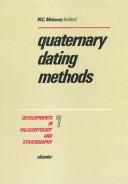| Listing 1 - 2 of 2 |
Sort by
|

ISBN: 0444423923 9786611756147 1281756148 0080868487 9780444423924 9780080868486 9781281756145 6611756140 Year: 1984 Volume: vol 7 Publisher: Amsterdam ; New York : Elsevier,
Abstract | Keywords | Export | Availability | Bookmark
 Loading...
Loading...Choose an application
- Reference Manager
- EndNote
- RefWorks (Direct export to RefWorks)
Quaternary Dating Methods
Issue --- Radioactieve datering. (Versch. onderwerpen) --- Geologische tijd. (Versch. onderwerpen) --- Géologie stratigraphique. Quaternaire. (Mélanges) --- Datation radioactive. (Mélanges) --- Temps géologique. (Mélanges) --- Geologie (Stratigrafische). Kwartair. (Versch. onderwerpen) --- Geological time. --- Geology, Stratigraphic --- Radioactive dating. --- Age determination, Radiometric --- Dating, Radioactive --- Dating, Radiometric --- Fission dating methods --- Radiometric age determination --- Radiometric dating --- Geochronometry --- Radioactivity --- Quaternary Period --- Age of rocks --- Geochronology --- Geochrony --- Rocks --- Time, Geological --- Chronology --- Historical geology --- Sequence stratigraphy --- Measurement --- Age
Book
ISBN: 0231546785 9780231546782 9780231186704 0231186703 Year: 2019 Publisher: New York : Columbia University Press,
Abstract | Keywords | Export | Availability | Bookmark
 Loading...
Loading...Choose an application
- Reference Manager
- EndNote
- RefWorks (Direct export to RefWorks)
There are few fields of science that carbon-14 has not touched. A radioactive isotope of carbon, it stands out for its unusually long half-life. Best known for its application to estimating the age of artifacts-carbon dating-carbon-14 helped reveal new chronologies of human civilization and geological time. Everything containing carbon, the basis of all life, could be placed in time according to the clock of radioactive decay, with research applications ranging from archeology to oceanography to climatology.In Hot Carbon, John F. Marra tells the untold story of this scientific revolution. He weaves together the workings of the many disciplines that employ carbon-14 with gripping tales of the individuals who pioneered its possibilities. He describes the concrete applications of carbon-14 to the study of all the stuff of life on earth, from climate science's understanding of change over time to his own work on oceanic photosynthesis with microscopic phytoplankton. Marra's engaging narrative encompasses nuclear testing, the peopling of the Americas, elephant poaching, and the flax plants used for the linen in the Shroud of Turin. Combining colorful narrative prose with accessible explanations of fundamental science, Hot Carbon is a thought-provoking exploration of how the power of carbon-14 informs our relationship to the past.
Carbon --- Radiocarbon dating. --- Radioactive dating. --- Age determination, Radiometric --- Dating, Radioactive --- Dating, Radiometric --- Fission dating methods --- Radiometric age determination --- Radiometric dating --- Geochronometry --- Radioactivity --- Carbon dating --- Carbon-14 dating --- Dating, Radiocarbon --- Archaeological dating --- Radioactive dating --- Radiocarbon --- Isotopes. --- Measurement --- Radiocarbon dating --- isotopes --- Carbone --- Datation --- Datation radioactive. --- Méthode du carbone 14 --- Méthode du carbone 14. --- Carbon - isotopes --- Méthode du carbone 14 --- Méthode du carbone 14.
| Listing 1 - 2 of 2 |
Sort by
|

 Search
Search Feedback
Feedback About
About Help
Help News
News